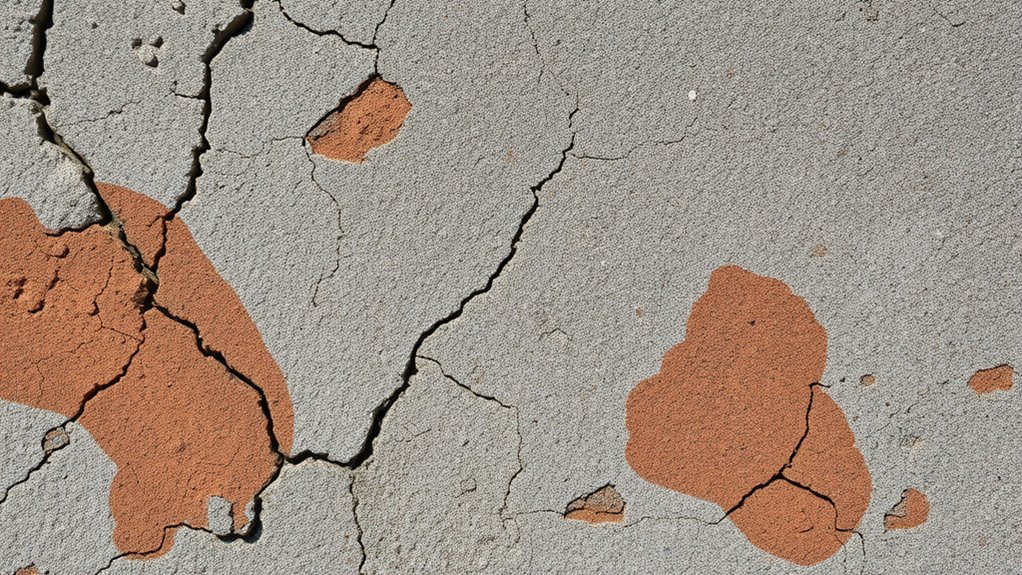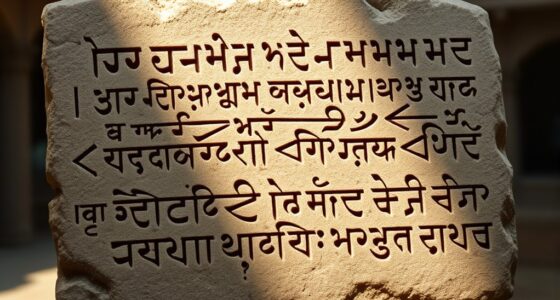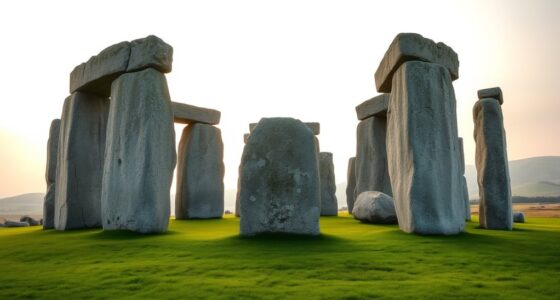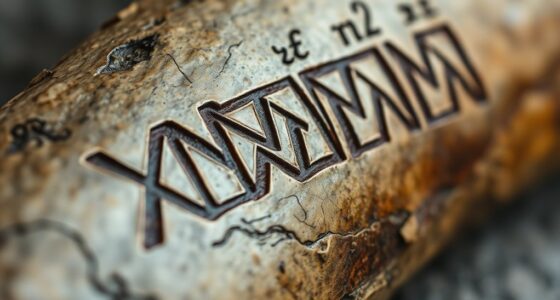Roman concrete still outperforms modern mixes because it contains volcanic ash that reacts with seawater to form durable mineral compounds. This mix creates a dense, resistant structure that withstands erosion, cracking, and long-term exposure to harsh marine environments. Unlike modern concrete, it doesn’t weaken over time, thanks to natural pozzolanic reactions. If you want to discover how this ancient technique can inspire sustainable construction today, keep exploring these remarkable materials.
Key Takeaways
- Roman concrete’s volcanic ash reacts with seawater to form resistant mineral compounds, enhancing durability.
- It incorporates volcanic byproducts that inhibit degradation and fill cracks through pozzolanic reactions.
- The material’s composition creates dense, erosion-resistant structures ideal for marine environments.
- Use of locally sourced volcanic ash ensures sustainability and optimal mineral properties for longevity.
- Its unique chemical reactions and material choices lead to structures that outlast many modern concrete constructions.
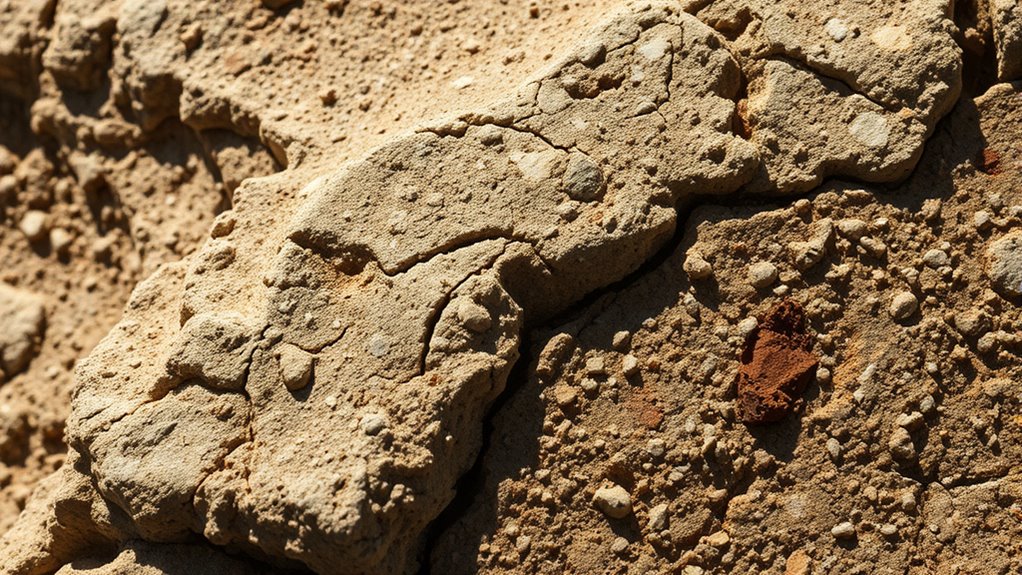
Have you ever wondered what made ancient Roman structures so durable? The secret lies in their innovative use of Roman concrete, a material that has stood the test of time much better than many modern mixtures. One of the key factors behind its longevity is its exceptional maritime resilience. Unlike contemporary concretes that often weaken when exposed to seawater, Roman concrete was specifically designed to withstand harsh marine environments. This resilience comes from its unique composition, which includes volcanic ash—a volcanic byproduct that played a vital role in strengthening the material. When mixed with lime and aggregate, volcanic ash reacts with seawater to form new minerals, creating a dense, resistant structure that resists cracking and erosion.
This volcanic ash isn’t just an ingredient; it’s the cornerstone of Roman concrete’s resilience. Its mineral properties help inhibit the chemical reactions that typically cause modern concrete to degrade over time, especially in saltwater environments. As seawater penetrates the material, the volcanic ash interacts with the water, forming calcium-aluminum-silicate hydrate compounds that fill in cracks and make the concrete more resistant to weathering. This process, known as pozzolanic reaction, enhances the concrete’s overall strength and longevity. That’s why many Roman harbors, piers, and underwater structures still stand today, despite centuries of exposure to aggressive marine conditions.
You might find it fascinating that the Romans didn’t just use volcanic ash randomly; they carefully selected specific types of ash sourced from volcanic regions around the Mediterranean. This deliberate choice created a material with extraordinary durability, unlike modern concrete, which often relies on chemical additives or synthetic materials to improve lifespan. The Roman approach to concrete was remarkably sustainable, utilizing locally available volcanic material to produce a resilient, long-lasting product. This innovation not only contributed to their impressive architectural feats but also allowed their structures to survive for millennia, often in the face of relentless sea waves, salt, and time.
In essence, Roman concrete’s enduring strength comes down to the clever use of volcanic ash, which imparts unparalleled maritime durability. By understanding and replicating this ancient technique, modern engineers are now exploring ways to create more sustainable and longer-lasting concrete. Additionally, the chemical stability of volcanic ash plays a crucial role in its ability to resist degradation, making Roman concrete a model of durability and resilience—an ancient secret that continues to inspire modern construction.
Frequently Asked Questions
Can Roman Concrete Be Used for Modern Construction Projects Today?
You can use Roman concrete for modern construction projects, especially when focusing on historical preservation. Its durability and longevity make it ideal for restoring ancient structures, showcasing timeless engineering. However, consider cost considerations, as Roman techniques may require specific materials or craftsmanship that can be expensive. While not always practical for all new builds, incorporating Roman concrete can add durability and authenticity to preservation efforts or specialized projects.
How Does Roman Concrete Resist Environmental Degradation Over Centuries?
Did you know Roman concrete has lasted over 2,000 years? Its resistance comes from pH neutrality, which prevents chemical breakdown, and mineral durability, ensuring longevity despite environmental challenges. Unlike modern mixtures, Roman concrete interacts with seawater, forming new minerals that strengthen the structure over time. This unique chemistry helps it resist erosion, saltwater damage, and weathering, making it incredibly resilient and outlasting many modern construction materials.
Are There Any Modern Materials That Mimic Roman Concrete’S Durability?
You’re curious if modern materials mimic ancient construction’s durability. Material innovation has led to some advanced concretes, like geopolymer and ultra-high-performance concrete, which aim to match Roman concrete’s longevity. Researchers study ancient techniques to develop sustainable, resilient structures. While these modern mixes aren’t identical, they’re inspired by Roman practices, showing that ancient construction principles continue to influence innovative materials designed to withstand environmental stresses over centuries.
What Specific Volcanic Ash Components Contribute to Roman Concrete’s Strength?
You might wonder what makes volcanic ash in Roman concrete so strong. Its volcanic ash composition contains silica and alumina, which trigger pozzolanic reaction mechanisms when combined with lime. These reactions produce additional calcium silicate hydrate, strengthening the material over time. This unique chemistry creates a durable, self-healing structure that outlasts many modern mixtures, making Roman concrete remarkably resilient even after centuries.
Is Roman Concrete Environmentally Sustainable Compared to Modern Concrete?
When considering if Roman concrete is more eco-friendly than modern mixes, you realize it often uses sustainable materials like volcanic ash, which require less energy to produce. This makes it a better choice for eco-friendly construction. You see that Roman concrete’s durability reduces the need for frequent repairs, lowering overall environmental impact. So, choosing ancient techniques can contribute to more sustainable construction practices today.
Conclusion
You see, Roman concrete has stood the test of time because it was built with a purpose and patience. Its secret ingredients and innovative techniques prove that sometimes, slow and steady wins the race. If modern engineers paid more attention to the past, they might just find the key to creating structures that last a lifetime. Don’t count out ancient wisdom just yet—sometimes, it’s the oldest tricks that still hold the most power.
